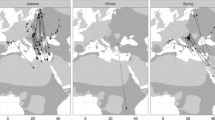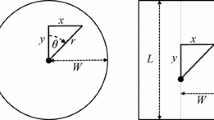Abstract
We examined ringing data for three common passerines at a migration monitoring site with the objective of determining how closely the numbers of birds captured reflected the actual numbers of birds passing through this site. Mark–recapture analyses were used, fitting smooth inter-annual changes in re-trapping probability and apparent survival (continued presence within the study area). For all three species we found systematic declines in re-trapping probability over the roughly three decades of our study; one species showed systematic increases in daily apparent survival over this same time period. Within individual years, daily variation in wind and rainfall were found to affect re-trapping probability and apparent survival. The result of all of these effects was that long-term trends in the numbers of unique individual birds captured systematically over-estimated the declines for all three species, providing clear indication that the biological interpretation of these raw capture totals from ringing stations will not necessarily reflect actual changes in the abundance of species passing through these sites.




Similar content being viewed by others
References
Bächler E, Schaub M (2007) The effects of permanent local emigration and encounter technique on stopover duration estimates as revealed by telemetry and mark-recapture. Condor 109:142–154
Berthold P, Schlenker R (1975) Das "Mettnau-Reit-Illmitz-Programm" - ein langfristiges Vogelfangprogramm der Vogelwarte Radolfzell mit vielfältiger Fragestellung. Vogelwarte 28:97–123
Berthold P, Fliege G, Heine G, Querner U, Schlenker R (1991) Autumn migration, resting behaviour, biometry and moult of small birds in Central Europe. Vogelwarte 36:1–221
Berthold P, Fiedler W, Schlenker R, Querner U (1998) 25-year study of the population development of central European songbirds: a general decline most evident in long-distance migrants. Naturwissenschaften 85:350–353
BirdLife International (1994) Birds in Europe: their conservation status. BirdLife Conservation series no. 3. BirdLife International, Cambridge
BirdLife International (2004) Birds in Europe: population estimates, trends and conservation status. BirdLife Conservation series no. 12. BirdLife International, Cambridge
Burnham KP, Anderson DR (2002) Model selection and multimodel inference: a practical information—theoretic approach. Springer, New York
Choquet R, Reboulet AM, Lebreton JD, Gimenez O, Pradel R (2005) U-CARE 2.2 user’s manual. CEFE, UMR 5175, CNRS, Montpellier
DeSante DF, Saracco JF, Burton KM, Walker BL (2004) Methodological considerations of the Monitoring Avian Productivity and Survival (MAPS) program. In: Ralph CJ, Dunn EH (eds) Monitoring bird populations using mist nets. Stud Avian Biol No 29:28–45
Faustino CR, Jennelle CS, Connolly V, Davis AK, Swarthout EC, Dhondt AA, Cooch EG (2004) Mycoplasma gallisepticum infection dynamics in a house finch population: seasonal variation in survival, encounter and transmission rate. J Anim Ecol 73:651–669
Harrison NM, Whitehouse MJ, Prince PA, Huin N (2000) What problems do local habitat change represent for the Constant Effort Site ringing scheme? Ringing Migr 20:1–8
Hines JE, Kendall WL, Nichols JD (2003) On the use of the robust design with transient capture-recapture models. Auk 120:1151–1158
Jennelle CS, Cooch EG, Conroy MJ, Senar JC (2007) State-specific detection probabilities and disease prevalence. Ecol Appl 17:154–167
Jenni L, Leuenberger M (1996) Capture efficiency of mist nets with comments on their role in the assessment of passerine habitat use. J Field Ornithol 67:263–274
Joehnk K, Straile D, Ostendorp W (2004) Water level variability and trends in Lake Constance in the light of the 1999 centennial flood. Limnologica 34:15–21
Julliard R, Jiguet F, Couvet D (2004) Evidence for the impact of global warming on the long-term population dynamics of common birds. Proc R Soc Lond B[Biol Lett Suppl] 271:S490–S492
Kéry M (2004) Extinction rate estimates for plant populations in revisitation studies: importance of detectability. Conserv Biol 18:570–574
Lloyds-Evans TL, Atwood JL (2004) 32 years of changes in passerine numbers during spring and fall migrations in coastal Massachusetts. Wilson Bull 116:1–16
MacKenzie DI (2006) Modeling the probability of resource use: the effect of, and dealing with, detecting a species imperfectly. J Wildl Manage 70:367–374
Morris SR, Liebner DA, Larracuente AM, Escamilla EM, Sheets HD (2005) Multiple-day constancy as an alternative to pooling for estimating mark-recapture stopover length in nearctic-neotropical migrant landbirds. Auk 122:319–328
Nilsson ALK, Londström Å, Jonzén N, Nilsson SG, Karlsson L (2006) The effect of climate change on partial migration—the blue tit paradox. Global Change Biol 12:2014–2022
Norvell RE, Howe F, Parrish JR (2003) A seven-year comparison of relative-abundance and distance-sampling methods. Auk 120:1013–1028
Ostendorp W (1999) Susceptibility of lakeside Phragmites reeds to environmental stresses: Examples from Lake Constance-Untersee (SW-Germany). Limnologica 29:21–27
Peach WJ, Ballie SR, Balmer DE (1998) Long-term changes in the abundance of passerines in Britain and Ireland as measured by constant effort mist-netting. Bird Study 45:257–275
Pradel R, Hines JE, Lebreton J-D, Nichols JD (1997) Capture-recapture survival models taking account of “transients.” Biometrics 53:60–72
Ralph CJ, Dunn EH (2004) Monitoring bird populations using mist nets. Stud Avian Biol 29:1–6
Salewski V, Thoma M, Schaub M (2007) Stopover of migrating birds: simultaneous analysis of different marking methods enhances the power of capture-recapture analyses. J Ornithol 148:29–37
Sauer JR, Link WA (2004) Some consequences of using counts of birds banded as indices to populations. In: Ralph CJ, Dunn EH (eds) Monitoring bird populations using mist nets. Stud Avian Biol 29:28–45
Schaub M, Pardel R, Jenni L, Lebreton J-D (2001) Migrating birds stop over longer than usually thought: an improved capture-recapture analysis. Ecology 82:852–859
Schaub M, Liechti F, Jenni J (2004) Departure of migrating European Robins, Erithacus rubelcula, from a stopover site in relation to wind and rain. Anim Behav 67:229–237
Schwarz CJ, Arnason AN (1996) A general methodology for the analysis of capture–recapture experiments in open populations. Biometrics 52:860–873
Senar JC, Conroy MJ (2004) Multi-state analysis of the impacts of avian pox on a population of Serins (Serinus serinus): the importance of estimating recapture rates. Anim Biodivers Conserv 27:133–146
Sokolov LV, Baumanis J, Leivits A, Poluda AM, Yefremov VD, Markovets MY, Morozov YG, Shapoval AP (2001) Comparative analysis of long-term monitoring data on numbers of passerines in nine European countries in the second half of the 20th century. Avian Ecol Behav 7:41–74
Viallefont A, Cooch EG, Cooke F (1995) Estimation of trade-offs with capture-recapture models: A case study on the lesser snow goose. J Appl Stat 22:847–861
White GC, Burnham KP (1999) Program MARK: survival estimation from populations of marked animals. Bird Study 46[Supp]:S120–139
Acknowledgments
We thank all of the people who participated in the collection of data at the Mettnau ringing station over the last decades. Specific mention must be made of Peter Berthold, Rolf Schlenker and Ulrich Querner who started the Mettnau ringing station and kept it running for over three decades. Insights and assistance with the software programme MARK from Gary White were essential to the completion of the analyses presented in this paper. Comments from Morten Frederiksen, Marc Kéry, Volker Salewski, Gavin Siriwardena, Michael Schaub and three anonymous reviewers greatly improved both our data analyses and the manuscript. Funding for the collection of data at the Mettnau ringing station and support for WF were provided by the Max Planck Society; earlier periods of work of the station were supported by the Deutsche Forschungsgemeinschaft and the German Ministry for Environmental Affairs. WMH thanks the Cornell Laboratory of Ornithology for allowing leave, which permitted the time to start work on the analyses presented in this manuscript. All work related to the handling of birds was done in compliance with German law (current permit No. 56-8853.17/01 Regierungspräsidium Freiburg).
Author information
Authors and Affiliations
Corresponding author
Additional information
Communicated by F. Bairlein.
Rights and permissions
About this article
Cite this article
Hochachka, W.M., Fiedler, W. Trends in trappability and stop-over duration can confound interpretations of population trajectories from long-term migration ringing studies. J Ornithol 149, 375–391 (2008). https://doi.org/10.1007/s10336-008-0282-1
Received:
Revised:
Accepted:
Published:
Issue Date:
DOI: https://doi.org/10.1007/s10336-008-0282-1




